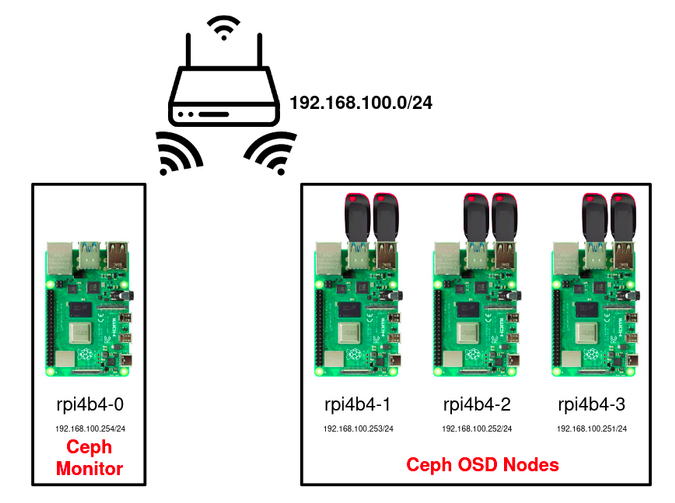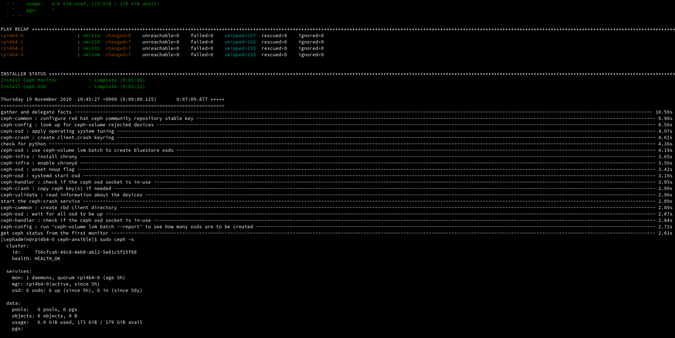Ceph is an open source software storage platform that provides object, block, and filesystem storage in a unified storage cluster. I first used Ceph when I integrated it with OpenStack. At first, I was confused about why I should use Ceph since storage devices are widely available. But after using it for more than three years, the platform's stability and integrity have proven its value again and again.
This article will show you how to install Ceph using ceph-ansible (an officially supported Ansible playbook for Ceph) and deploy it in a Raspberry Pi cluster.
Materials:
- Four Raspberry Pi 4B 4GB models
- Four 32GB microSD cards (boot OS)
- Four Raspberry Pi cases with fans and heatsinks (very important)
- Four Raspberry Pi chargers
- Six 32GB USB flash drives (for the Ceph OSD nodes)
Architecture:

(Aaron John Canlas, CC BY-SA 4.0)
Regarding the configuration:
- Both the front-end and back-end networks are in the same subnet
- The Ceph Monitor software uses a Raspberry Pi 4B with 4GB RAM
- The Ceph OSD nodes use the same Raspberry Pi model but with two USB flash drives for the OSD disks
Deploy Ceph using ceph-ansible
Using Ceph's Ansible repository makes the deployment smooth and simple.
1. Copy ssh keys to all servers
I have a common user called cephadmin on all servers (each Raspberry Pi is a server in this context). The cephadmin user is configured with passwordless sudo to make things easier.
After generating a key using ssh-keygen, deploy all keys using ssh-copy-id.
I use a Bash for-loop because I'm using consistent and incremental hostnames:
$ for i in {0..3}; \
do ssh-copy-id cephadmin@rpi4b4-$i; \
doneYou need to accept and enter your password on each one, but you can automate this with expect.
2. Clone ceph-ansible and install requirements
Install Git to clone the repository:
$ sudo yum install git -yClone the ceph-ansible repository:
$ git clone https://github.com/ceph/ceph-ansible.git
$ cd ceph-ansible/I'm using an AArch64 build of CentOS 7, so I must install some required packages before continuing.
First, Python pip:
$ sudo yum install python3-pip -yThen the packages ceph-ansible needs:
$ sudo yum install python3-devel libffi-devel openssl-devel -yFinally, the requirements ceph-ansible needs:
$ pip3 install -r requirements.txt --userI received this error:
You are linking against OpenSSL 1.0.2, which is no longer supported by the OpenSSL project.
To use this version of cryptography you need to upgrade to a newer version of OpenSSL. For
this version only you can also set the environment variable
CRYPTOGRAPHY_ALLOW_OPENSSL_102 to allow OpenSSL 1.0.2.This may be related to the architecture, because I can't replicate the error in a CentOS 7 virtual machine.
For deployment, export CRYPTOGRAPHY_ALLOW_OPENSSL_102 to True so that Ansible can run:
$ export CRYPTOGRAPHY_ALLOW_OPENSSL_102=True3. Configure ceph-ansible for deployment
Now you're ready to deploy Ceph using ceph-ansible.
Copy site.yml.sample to site.yml:
$ mv site.yml.sample site.ymlCreate all.yml in the group_vars directory:
$ cat << EOF >> group_vars/all.yml
ceph_origin: repository
ceph_repository: community
ceph_repository_type: cdn
ceph_stable_release: nautilus
monitor_interface: wlan0
public_network: "192.168.100.0/24"
cluster_network: "192.168.100.0/24"
dashboard_enabled: false
configure_firewall: false
EOFCreate osds.yml in the group_vars directory:
$ cat << EOF >> group_vars/all.yml
osd_scenario: collocated
devices:
- /dev/sda
- /dev/sdb
EOFCreate an inventory file:
$ cat << EOF >> inventory
[mons]
rpi4b4-0
[osds]
rpi4b4-1
rpi4b4-2
rpi4b4-3
EOFAs of this writing, there is a bug in the ceph-ansible repository (according to this bug ticket). You can mitigate the bug by editing line 85 and 86 of the roles:
- (wait_for_all_osds_up.stdout | from_json)["osdmap"]["num_osds"] | int > 0
- (wait_for_all_osds_up.stdout | from_json)["osdmap"]["num_osds"] == (wait_for_all_osds_up.stdout | from_json)["osdmap"]["num_up_osds"]4. Deploy Ceph
Run the Ansible playbook with your inventory file:
$ ansible-playbook -i inventory site.ymlAfter 15–20 minutes, you should see this result:

(Aaron John Canlas, CC BY-SA 4.0)
Next steps
Previously, I manually deployed an OpenStack cluster in another Raspberry Pi cluster. I hope to integrate it with this one. I'm also looking into deploying with TripleO.
The possibilities for Raspberry Pi, Ansible, and OpenStack are endless. Get started with your own experiment, and let me know how it goes in the comments.










Comments are closed.